Stepintime (talk | contribs) (Adding categories) Tag: categoryselect |
Stepintime (talk | contribs) (Adding categories) Tag: categoryselect |
||
| Line 144: | Line 144: | ||
According to the 2007 Alaskan Census approximately 85% identify as believing Orthodox Christians. 58% of Cossacks also identified themselves as having Ukrainian ancestry, 22% as having Russian ancestry, 10% as being Cossack alone, 5% being of Indian (native) ancestry and 4% as having Hispanic ancestry. Cossacks on average earn a salary of sixty thousand yemfolk annually. |
According to the 2007 Alaskan Census approximately 85% identify as believing Orthodox Christians. 58% of Cossacks also identified themselves as having Ukrainian ancestry, 22% as having Russian ancestry, 10% as being Cossack alone, 5% being of Indian (native) ancestry and 4% as having Hispanic ancestry. Cossacks on average earn a salary of sixty thousand yemfolk annually. |
||
[[Category:Cultures]] |
[[Category:Cultures]] |
||
| + | [[Category:Culture]] |
||
Revision as of 23:03, 19 November 2016

|
The following Russian America page or section is a proposal.
It has not been ratified and is therefore not currently part of the Russian America timeline. You are welcome to correct any errors and/or comment on the talk page. If you add this template to an article, please don't forget to mention this proposal on the main discussion page. |
Cossack Alaskan (circa 1905).
Cossack Alaskans (Russian: Казацкие аляскинцы, Kazatskiye alyaskintsy; Ukrainian: Козацькі аляскінці, Kozats'ki alyaskintsi) are citizens of the Alaskan Democratic Federative Republic who are culturally or ethnically associated with the Cossacks. In contrast to the Cossack communities of Eurasia, the Sitka Alaskan definition is broader and can include all citizens who self-identify as Cossacks.
Cossacks first came to North America in the 19th Century. The Cossacks established several hosts across Russian America. Unique to both the Russian Empire and North America, these Cossack communities were and are self-governing, semi-militaristic, and democratic. It has been argued that the Cossack identity of autonomy and democracy played a key role in Alaska's independence and continues to play a role in mainstream Alaskan culture.
As of the 2007 Alaskan census, approximately two million stated their ancestry as being Cossack. Virtually all Cossack Alaskans can trace their ancestry back to Southern Russia and Ukraine, though traces can be found from across the former Russian Empire.
History
Early Colonization
Cossacks have been part of Alaska since the first native wars, particularly the battle of New Archangel (1804). After this initial conflict only some of the Cossacks remained to protect the fledgling frontier of around Castle Hill. Nikolai Rezanov lobbied with the czar for continued intervention by to serve as an effective garrison force against raids from the native Tlingit tribe. During the Napoleonic Wars imperial authorities saw no need to direct attention to a distant overseas colony. After the fall of Napoleon fur trading expeditions grew in number and profit. After a Tlingit ambush raid killed a minor noble man and an entire fur trading party the first Alaskan Cossack hold was established in 1818. Forty Cossacks from the Russian far east were assigned to protect the Castle Hill fort in modern day New Archangel. As a small group the first Cossacks were used as scouts and to hunt down night raiders. Before 1840 Cossacks consisted of a large group in the New Archangel colony, and became in effect the actual government of the colony with the Russian American Company providing only a secondary role.
The Spanish War
Prior to the outbreak of the Russo-Spanish war Cossacks were not common around Fort Ross. Preserved colonial records from the fort do mention a small party of Cossacks selling otter pelts in the 1820's. Arriving in 1823 hundreds of Cossacks made their first large scale presence in Alaska. Cossacks swiftly pillaged Spanish frontier towns and missions in what is now Nevada (OTL California) contributing to the collapse of Spanish North America. Allegedly Cossacks spared the lives of Catholic clergy in frontier settlements in an otherwise merciless colonial war, but this is disputed from certain Spanish historians. Some of those captured by Cossacks were Mexican sympathizers willing to cooperate.
Cossacks were deployed during the last stages of Mexico's independence war, crucially supporting the early Mexican state while it remained vulnerable, Cossacks in Mexico were auxiliaries cutting off retreat of fleeing Spanish armies speeding the end of the independence war in Mexico. In the long term the favorable Cossack intervention laid the foundation for Mexico's and Alaska's friendly relations which continue to the present. The fearsome tradition of the Cossacks against the Spanish inspired the Mexican Vaqueros to be more militaristic, later giving to the rise of horse gangs.
Upon the end of the war Czar Nicholas gave large plots of land in Sonora to the Cossacks by imperial decree, making the way for 5,000 Cossacks alone to arrive by 1835. With wives and children the communities became a foundation for the large scale presence in South Alaska; North Alaska still separated from the new lands acquired from Spain developed its own Cossack identity and culture.
Establishment in the American Krai
The Cossack experience and their relations with others varied widely in the American Krai as vastly different locations and climates demanded different behaviors of the Cossacks who were increasingly being used by colonial authorities as explorers, law enforcement, emissaries as well as garrison soldiers.
In the 1830's many Cossack holds were established in what is now roughly Northern Sitka. The missions of the horse backed classed warriors were multi pronged to finally pacify the area, resettle and integrate indigenous people with Slavic civilization. With the lack of imported women many Cossacks regardless of origin intermarried with natives causing both tension and more familiarity between natives and Cossacks. Cossacks changed the hierarchy of native peoples in Alaska by offering membership to those who were willing warriors against enemies. Previously subjugated by Tlingit many Athabaskans eventually allied with the Cossacks against their traditional enemies. Despite some success at assimilation yearly summer wars continued, the Tlingit increasingly took to brutal measures to maintain their autonomy. In 1843 Cossacks exterminated several native villages of several different tribes in response to a massacre of Christian Athabaskans the year before. The Tlingit wars did not end until the late 1850's, most of the combatants were pioneers and Cossacks with only occasional regular soldiers.
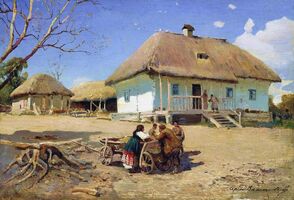
Depiction of what a traditional Cossack Hold would have looked like in the mid nineteenth century
In New Russia and East Yukon and other northern governates Cossacks had effective independence from colonial authorities, the ambiguous wide reaching borders consequently meant that patrolling Cossacks met British fur trappers led to trade or violence. Cossack and British meetings started the first overland network in the pacific northwest. Father south Cossacks confronted English speaking mountain men that had already been present for two decades by the end of the Spanish war
In the south several Cossack holds were created on the new Mexican border. While considerably closer to colonial authority than their northern cousins many still took on semi nomadic life styles. Frequent interactions occurred with Mexicans as Cossacks effectively became border guards. Native Pomo people attempted to hide from Cossacks but in the long term contact was unavoidable. Less violent than other areas many Pomo eventually joined Cossack society. Cossacks were at odds with minority herding Kalmyk and other Mongolian newcomers to the area over resources and religious differences of the two communities. Cossacks were the legal enforcers of imperial authority during this period, creating a militaristic upper class
Tensions sparked between Cossacks and other pioneers as Cossacks held their own interests supreme over other Russians and Ukrainians. While they officially represented the imperial government their decisions became independent from imperial authority. Traditional Cossack democracy contrasted with the rest of Alaskan society at the time leading Czarist officials to call for stricter imperial oversight over the Cossacks. Other pioneers, seeing the example of the Cossacks began to ask for a democratic representation of Alaska's people.
Rogues and Loyal Cossacks
Up to the late 1860's colonial government authority existed only in port cites with Cossacks controlling outside territories and intervening in the cites at will. As Alaska's s society grew in complexity Tsar Alexander II saw the need to rely on other sources of law enforcement in the colonies than the Cossacks. Simultaneously Alaskan reforms were issued with reforms with Russia proper. Russia's new world colonies were given permanent garrison of regulars apart from the Cossacks and oblasts were to create their own bureaucracies subject to the commands of the army than to the Cossacks. Unclaimed lands were opened to regular veterans and civilian pioneers. The autonomy of Cossacks were curtailed, Cossacks were relegated to colonial frontiers and were restricted from taking part in economic activities such as mining or cash crop farming to not compete with other newcomers.
Some groups opted to revolt making however, almost all of these uprisings were put down by Cossack leadership. A minority of clans and individuals left the holds illegally, becoming rogues. Some left for Borealia and the U.S territory of Abaroskia. In 1874, rogues fought with U.S Cavalry before dissolving into the wilderness, similar instances occurred with Borealian Mounties. As these rogues settled in remote parts of the United States and Borealian frontier some Cossack descendants exist in these countries today.
Typically those who broke away formed gangs, terrorizing pioneer communities and running infamous khanates by collecting protection tribute from new settlers. On the side some rogues also mined and herded at the same time. The eastern frontiers turned lawless, Cossack gangs often fought each other and loyal Cossacks. Loyalists had difficulties breaking gangs due to vast distances, mountainous terrain and the elusiveness of rogues. The struggle between loyalists and rogues made a backdrop for later romance in Alaska's culture. Rogues and loyalists were later depicted as different schools of faithful ideologies- even though real decisions of Cossacks were usually of material self interest.
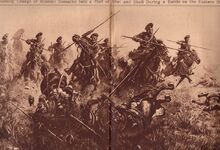
A drawing of a rogue gang, done by an eyewitness was posted in local Alaskan newspapers in 1879.
Throughout the latter half of the 19th century rogues remained persistent throughout the 1890's, loyalists took to many measures to prevent their own from defecting and to bring rogues back into the holds. Both negotiation and intimidation were common place, turn coating was fairly common. Loyalists increasingly desperate began mass executions of rouges to convince colonial authorities the problem was solved.
Despite marginalization and rogue trouble Cossacks remained important for Russian America. Cossacks were valued most for their mobility and tenacity, Cossacks were dispatched to assume control over purchased territories from the British and as messengers. Fear of an American invasion that never happened in the 1890's led to enlargement of existing holds in Idaho and Oregon. Holds were also used to control affairs with native Amerindians. During the Russo Japanese War, some Cossacks were recruited as intelligence agents to "maintain" the people's loyalty.
The increased number of settlers by late 1890's eventually led to the decline of organized horseback rogues, new technology also changed the way rogues operated. However, rogues continued to persist through the Alaskan Wars. Romance of rogue loyalists infighting is credited for aiding the rise of the Nasha America movement, by standards of the time Cossacks in the new world experienced unprecedented independence compared to other settlers and Eurasian Cossacks.
Alaskan Wars
In the last years before revolution colonial authorities again relied on Cossacks to maintain order because of their difference from the general population. However, loyalty within the Cossacks diminished after many were sent to Europe during WWI.
In The initial revolution of 1919 only a few Cossack holds defended the short lived oligarchy in the American Krai. Many holds participated in the overthrow tipping the balance in Oregon against reactionary forces. The ensuing chaos divided Cossacks on ideological and regional loyalties. Cossacks supported the workers revolution in Ross, but defended the conservatives in New Archangel. There was initial support for egalitarian Communism among Cossacks until the Alaskan Socialist Republic forcibly confiscated Cossack property within their territory. Cossacks fought bitterly against Doug attempts to derussify Colombia.
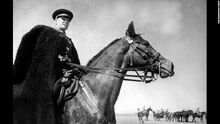
A Cossack officer watches the border between New Archangel and Columbia, 1928
Most Cossack immigrants had been veterans in the White Army, becoming the foundation of the Alaskan monarchists. Cossacks were known for occasional war crimes against soldiers of the Alaskan Socialist Republic. Through the 1920's Cossacks differed on whether they were in Northern or Southern Alaska Due to the white emigre movement Cossacks in the north were more Eurasian while the majority of Cossacks in the south were distinct Alaskans by nationality. In Sonoma Cossacks joined the civilian government and held seats in Ross for reputation, the old tradition of democracy within Cossack communities inspired many blues in creating a republic In contrast northern Cossacks reluctantly accepted the democratic revolution in New Archangel.
As reunification progressed in the 1930's Cossack's were acknowledged as an ethnic and para-military class and were granted political representation. Cossack police forces were also authorized for the first time. Militarily Cossacks were still distinct as a separate contingent of armed forces. Evidenced in movies and news reels at the time Ukrainian Alaskans were especially supportive of Cossacks at this time, many of whom had previous connections to Cossacks.
Cossack Alaskans that remained in the Alaskan Socialist Republic were forced to renounce allegiance to their holds and people or otherwise face imprisonment. Approximately 3,000 Cossacks were liberated in the short 1941 reunification war. Reunified Alaska maintained recognition of Cossacks and repatriated Cossacks for losses during the Alaskan Revolution.
Popularization
In the newly unified Alaska the government used Cossack heritage to distinguish Alaskan nationality from their former colonizers and the Soviets. The government sponsored Everyone is a Cossack campaign saw posters distributed nation wide linking Cossacks with the rest of Alaska's pioneering culture. Cinema serials depicted Cossacks as chivalrous fighters of the highest moral aptitude. From the late 1940's through the early 1960's Cossacks were in the media valiant defenders of the nation's sovereignty. By echoing colonization and traditional Slavic values Cossacks were a symbol of independent Alaska.
After the Alaskan missile crisis and the following election of Vasily Kardash the popular tone changed, both the government and private media shifted from the previous noble image of Cossacks. The larger Cossack image began to focus on the rogue. The Cossack image was sold along apparel, gadgets and automobiles as a symbol of independence. Rogues were presented both as suave swashbucklers and freedom fighters. The film New Bullets filmed both in Alaska and the United States portrayed Cossack rogues as being akin to youth rebellion. In the United States rogues were given a positive portrayal similar to that of golden age of piracy. .
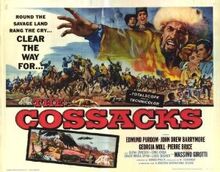
A poster for the 1959, American cut of the Cossacki film Many films on Cossacks have reached an international audience in the past fifty years.
The contrasting images of Cossacks clashed with each other. The majority of Hold Cossacks found rogue stereotypes to be revolting while younger descendants of Cossacks embraced the rogues. Ideas about Cossacks became politically polarized as conservatives embraced the earlier pop culture image of Cossacks and liberals gravitated closer to association of Cossacks with rogues. Through the Cold War the Cossacks were universally embraced by the majority of Alaskans as positive role models.
Cossacks still residing in holds felt their identity was threatened and asserted their local independence from other communities. The "You are not me, I am not you" slogan became a rallying cry for conservative Cossacks. Generally Cossacks became more exclusive on insisting that one must live among fellow Cossack to be a Cossack. At the same time Cossacks started to be criticized by certain groups such as certain Native American Tribes, Feminists and pacifists.
The wave of post Soviet emigres in the 1990's oriented Cossacks to change again, as communities were unsure on how to respond on immigrants identifying as Soviet refugees. Most Alaskan Cossacks eventually embraced Eurasian Cossacks as their brethren and have since made organizations to help in this kind of inclusiveness for new Cossack immigrants. There is a smaller exodus of Alaskan Cossacks to Ukraine that has taken place since 1990.
Inspired by the rise of rap of the inner cities of the United States, Cossack Alaskans began developing rap routines in the 1990's creating a new genre Cossack Rap. To date Cossack Rap(Russian:казачьи сказки,kazach'i skazki) is one of the most popular genres in the Russian speaking world. Tracks usually combine traditional Slavic folk instruments with beats. Lyrics are often about Rouges, immigration, and personal struggles.
Cossacks continue to capture public imagination and controversy. Many Alaskans proudly display signs of their heritage and in cooperate their ancestry into holidays and festivities. Other Alaskans without Cossack heritage aspire to be Cossacks by joining Cossack communities via Cossack police or the exclusive Cossack branch of the military.
Present role
Officially Cossacks exist as an ethnicity recognized by the Alaskan Census, a minority- 400,000 live within holds or majority Cossack Communities. Holds are defined as "historic property and gathering areas for the Cossack Community before 1941", encompassing a broader idea of what identifies a modern hold.
Cossack Corps
As a federal function Cossacks still retain their branch in the Alaskan military, the Cossack Corps specializes in special and covert operations. The Cossack Corps has only twenty thousand personnel and is considered exclusive, until 1970 one had to prove they at least one parent had to be a member of a Cossack Hold. Since then outsiders have been permitted as a necessity for keeping ranks. Most in the Cossack Corps are raised from a young age to prepare to join, most join between 18 and 21 but the eldest age of selection is 30. All must undergo competitive physical and academic tests to be eligible for selection by the corps officers, usually new recruits sign 15 year contracts and are promoted to high officer rankings if they choose to stay beyond that time. Women were recently permitted to enlist for the first time in 2010.
In 2013 the Cossack Corps was scandalized by an incident of three training deaths in an Idaho base. Cossack Corps were the subject of the 1999 block buster film Our Land about counter espionage against the Soviets.
Cossack Police
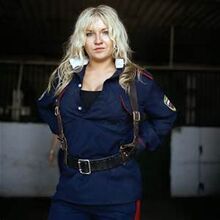
A Cossack policewoman
Nearly all Cossack majority communities are protected by Cossack Police, permitted by the federal government to police its jurisdiction. Cossack Police are managed jointly by civilian government and unions in Cossack holds. Membership is more exclusive than ordinary police but is technically open to all Alaskan citizens. Employment as a Cossack Police officer is often considered a life time profession. Cossack Police serve a number of functions besides community safety including anti trafficking and range patrol. In National Parks and other protected areas Cossack police are commonly mounted.
Cossack Police are occasionally requested by other jurisdiction for assistance in high profile cases, there are also private Cossack security companies. Cossack in this term is by one who has experienced rigorous Cossack style training and lifestyle
Cossack Society
Defining "Cossack Society" is broad because of the vast differences between different groups of people who consider themselves Cossack, Alaskan census takers do acknowledge those who reside in Cossack holds as "hold stayers" being distinct from those who live outside alongside non-Cossacks. Those not in the holds are simply called outsiders,
Hold Stayers are conservative, egalitarian and overwhelmingly religious. Over 94% of those residing in holds states themselves as regular church goers to Alaskan Orthodox Churches. Cossacks tend to live in extended families with at least three three generations. Hold stayer families usually have traditional gender roles with exceptions with women who enlist in the service. Women in the service has begun to stir changes in the Cossack community with the question of whether female veterans of service should still perform traditional gender roles.
While families own their property strong community bonds mean Hold Stayers share with each other and address the community's welfare jointly. Holds have their own sporting leagues for children, and youth to encourage athletic excellence, to build family pride and prepare the next generation for military and police service.
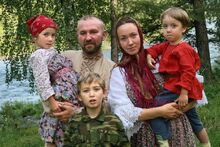
A traditional Cossack Alaskan family
Hold Stayers maintain their own schools funded jointly by local taxes and Cossacks themselves. Within modern holds the old tradition of democracy remains and encourages meritocracy for aspiring Cossacks. Generally crime is very low and hold areas as individuals fear the consequences of social isolation more than court punishments. To the present hold stayers remain a lifestyle that is rigid and partially collectivist. Approximately 10% of adult hold stayers are foreign born from the former U.S.S.R.
Those outside the holds are often looked upon negatively by hold stayers for leaving their comrades behind. Those Cossacks who live in the general population generally live alone or in nuclear families. Hold Outsiders express their heritage in intense but private physical training, horseback riding, shooting and in dressing as traditional Cossacks. Outsiders emphasize the values of independence cherished by their forebears in colonial Alaska. Cossack Outsiders have their own biker gang of motorcycle enthusiasts that can often be seen touring throughout all of Alaska.
Popular Culture
For most of Alaska's cultural history Cossacks have present in some shape or form, with changes in the depiction of Cossacks reflecting the directions of Alaska's society. There has been thousands of fictional books written on Cossacks and about one hundred movies with a Cossack being a protagonist. Occasionally stereotypical Cossacks roles are played by character actors. Major film critics say Cossacks are usually depicted as stern, bullish and honest. Since the 1960's Cossack imagery has been a major part of marketing, home and daily use products are often marketed with a traditional looking Cossack as in the case of the Cossack cereal brand.
On the other hand fast food, luxury cars and leather jacket apparel are marketed with a rogue or an otherwise crazy figure still bearing some Cossack resemblance such as a horse and bear cap.
Major Movies
Cossacki (1957) - Funded jointly by the Alaskan government and the Russ cooperation. One of the best examples of the traditional portrayal of Good Cossacks. The story is set on a band of Cossack brothers. The film tells an established story of Cossack history, about arriving in the colonies, and creating with their efforts a new world for their country men. Against the antagonism of violent natives and corrupt officials the brothers protect peasant colonists and convert some oppressed tribes people to Christianity.
Our Land (1999)- Renowned for its cast combining actors from both Alaska and the Soviet Union is a dramatized story of real life counter intelligence efforts of the Cossack Corps against the K.G.B. The movie was experimental for exploring how the Cossack Corps and the K.G.B often had similar struggles despite bitterly hating each other..
New Bullets (1968)- A hit in the late 60's a story is told about the rise of the rogues in late 19th century. A young Cossack deserts his hold when his brother is imprisoned for violating rules, freeing his brother a gang is created. The main character titled "Trouble " elopes with a Ute woman while pillaging the countryside. This movie is famous for being one of the first in Alaska to depict vice not just as glamorous but sometimes morally right against tyranny. The movie is still a symbol of youth rebellion.
On the edge of high Mountain (2002). An American movie about an officer Nathan Aldrich, assigned to put down an Indian rebellion he is ambushed by both Cossack rogues and native Americans. Later Aldrich is inspired by their way of life and joins them.
An original Cossacki poster, 1957
Trampling Hooves (1929). A Soviet silent film depicting the oppression of peasants in the white army, remembered most for its visuals and dramatic expressions of the cast. In the climax peasants liberated by the red army prevent fleeing Cossacks from fleeing to a "foreign country", presumably thought of as Alaska.
Birth of Freedom (1980) A Mexican movie about the end of the independence war from Spain, Cossack characters have major supporting roles and turn the tide in the climatic battle against the Spanish.
Criticism
Since independence Cossack Alaskans have been the subject of public criticism from certain groups; including but not limited to, feminists, pacifists, indigenous Alaskans and parts of academia.
International criticism of Alaska's handling of Cossack affairs has come from Soviet states and affiliated organizations. Most criticism is directed at Cossack holds but sometimes Cossack outsiders are lumped in or ridiculed.
Soviet Criticism
Before the unification of the Alaska in 1941 both the governments of the Soviet Union and the Alaskan Socialist Republic said that friendly relations between Cossacks and Alaskan states were a conspiracy. Soviet Theaters made productions through the 1930's and 40's depicting Cossacks as class oppressors being used by white emigres to crush revolutions of the people. Throughout the first four decades of the Soviet Union's existence Cossacks and Alaska were criticized together. Before the missile crisis Alaska was almost always reduced to a character with Cossacks in mind, termed collectively as the Tsar's children. After the missile crisis Soviet media portrayed modern Cossacks as rogues as criminals and thieves who profited from extortion of civilians.
When the Soviet Union began to reform in the late 1980s attempts were made to rectify the relationship Alaskan Cossacks and Communist officials. Cossacks for the first time were acknowledged to have a critical and sometimes positive role in the development of Russian History. Cossack families long separated by the Cold War were allowed to visit each other for the first time in 1987.
The emergence of the Socialist Russian Federation has created an fluctuating relationship between Alaskan Cossacks and Communism mostly on account of government treatment of remaining Cossack Russians. The Russian government claims to attempt to preserve groups and organizations that are part of Russia's historic culture including the Cossacks by any means possible. These claims continued to be received with skepticism from Alaskan Cossacks
By feminists
The conservative culture and traditional family values of Cossacks are commonly stated by Alaskan feminists to be vehicles to female exploitation and entrapment. From the late 60's feminist demonstrations outside of holds have been a major source of controversy. Cases of alleged Cossack police brutality against feminists garner public protest and mass media attention.
Cossacks in response claim that feminism uninvited is an aggressive attack on the way of life of Cossack women who willingly choose to remain in Cossack Society. Feminist criticism that Cossack women were barred from fulfilling their true potential via military opportunities was answered by the opening of the Cossack Corps to women in 2010. .
By Dougs (English Alaskans)
Tension remains in governates that were once part of New Albion, some Alaskans of English heritage continue to resent Cossacks. Local English historians claim Cossack violence against English during the Alaskan Wars is underrepresented and Cossacks are granted too many privileges by the federal government. In the past twenty years several counties with being governed by the Civil Alliance party have passed Anti Cossack laws forbidding the entrance of Cossack police on duty or for a Cossack to come with any of arms and modification of school history curriculum. However since 2014 the Supreme Court has invalidated some of these new laws as unconstitutional.
By Alaskan Indians
Relations between Indians and Cossacks are varied, over the course of Alaskan history some native tribes aligned with Cossacks or even joined them, this goes for the Athabaskan tribes for example. However, other tribes still regard Cossacks as guilty of theft, mass murder and ethnic cleansing. Since the formation of the present Alaskan state several tribes have sued Cossack holds, regional and federal government for reparations. The 2000 case of Tlingit v.s Yakut initiated by Tlingit elders on account of Cossack brutality in the colonial Tlingit wars saw a compromise. The Cossack hold was obligated to give reparations of a million Alaskan yemfolk but did not have to cede any seized lands from the colonial period.
Demographics
According to the 2007 Alaskan Census approximately 85% identify as believing Orthodox Christians. 58% of Cossacks also identified themselves as having Ukrainian ancestry, 22% as having Russian ancestry, 10% as being Cossack alone, 5% being of Indian (native) ancestry and 4% as having Hispanic ancestry. Cossacks on average earn a salary of sixty thousand yemfolk annually.
